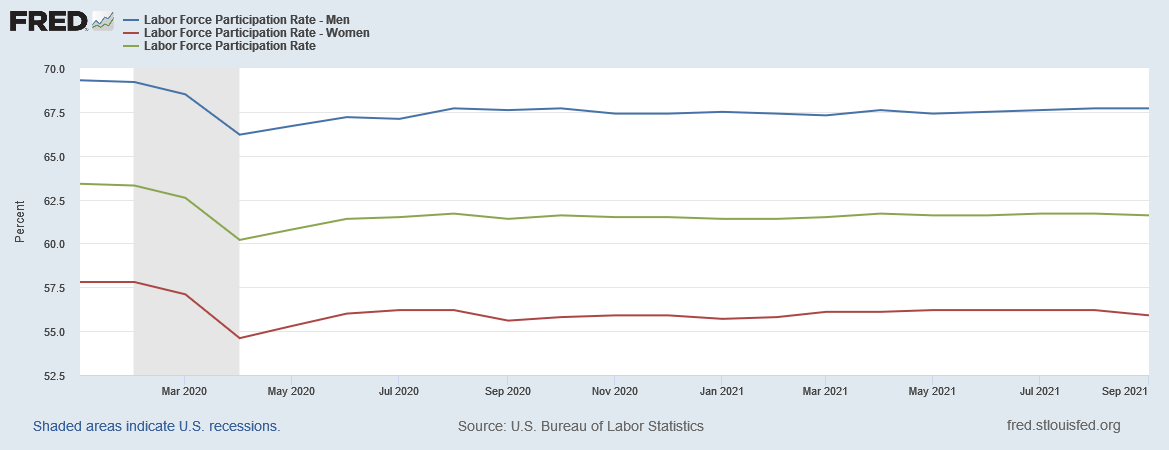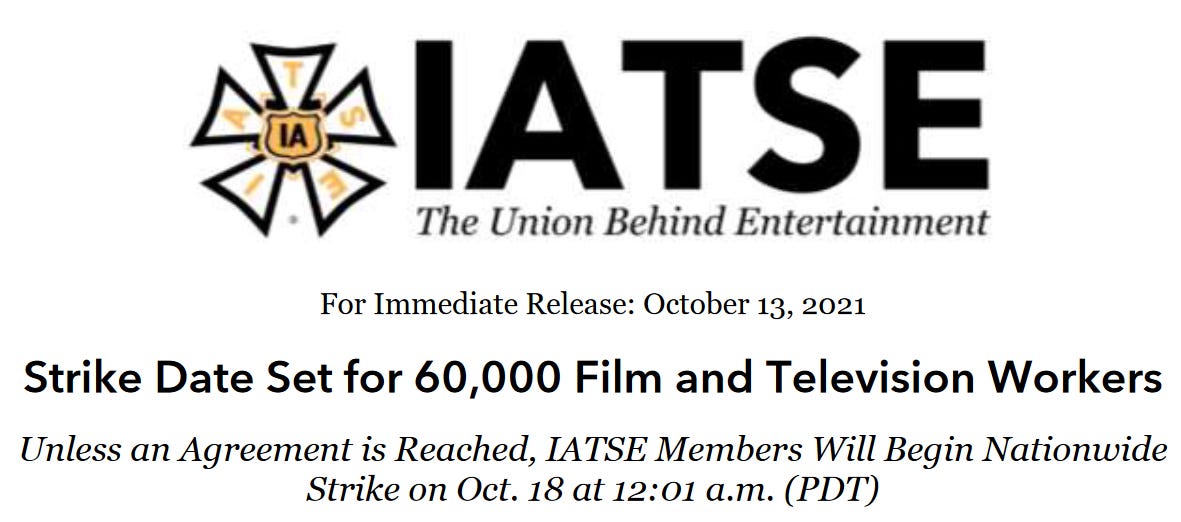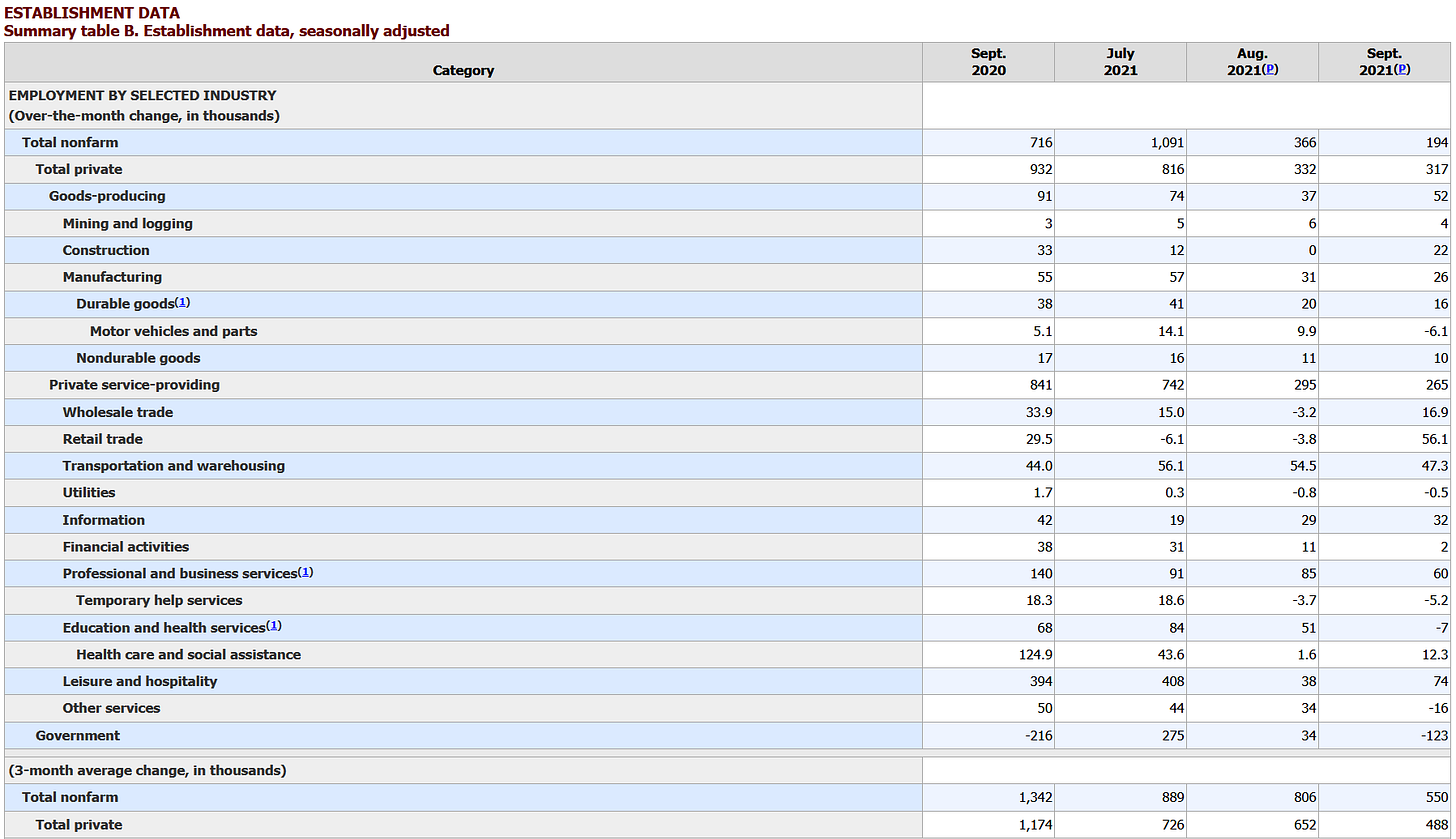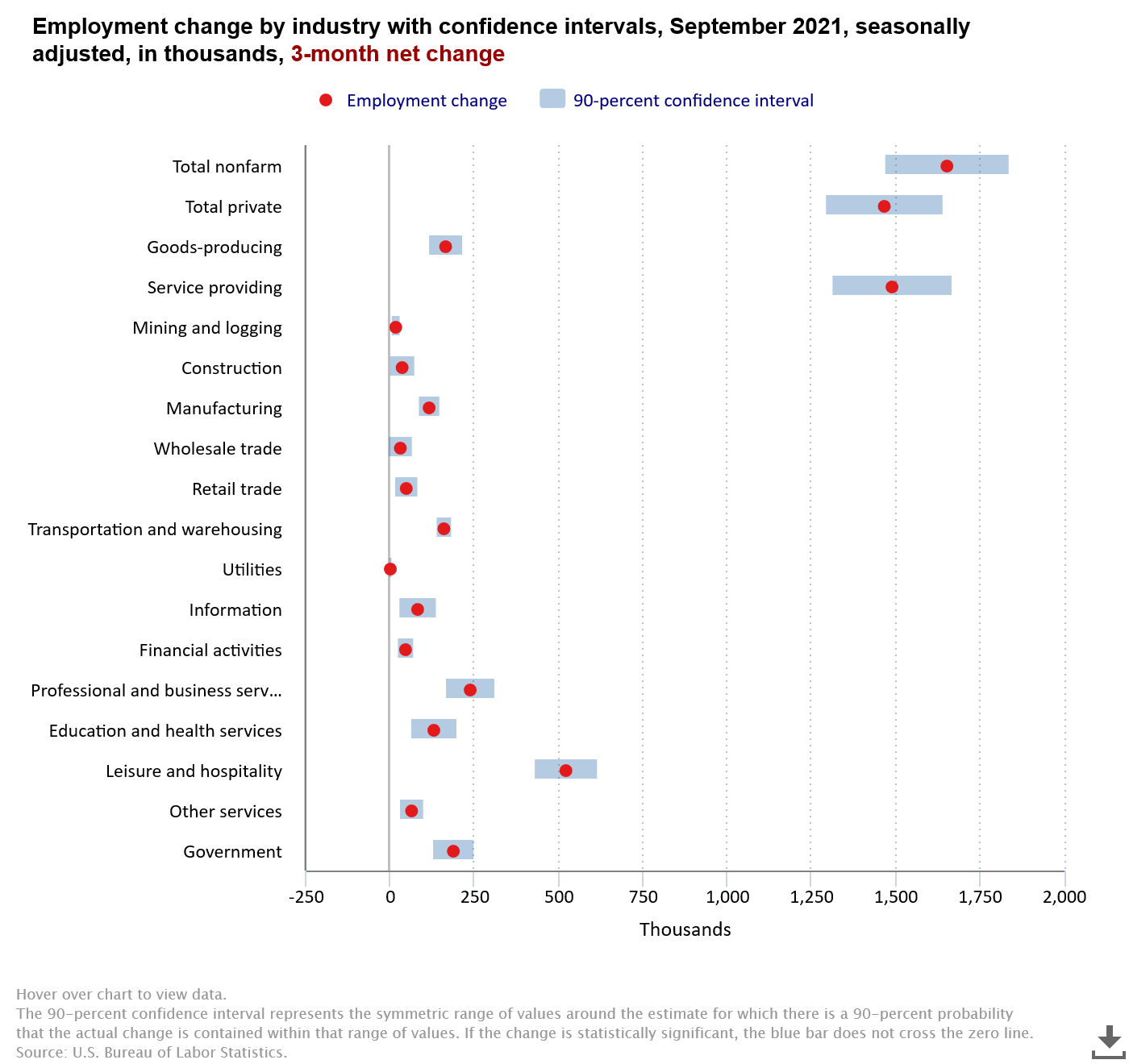Workers Strike for Economic Justice After Second Month of Slowing Job Growth
September 2021 Jobs Report Analysis
September 2021 was the slowest month of job growth of the year, but there are promising signs of worker empowerment and solidarity which may ultimately be among the first steps towards a brighter future. With many high-profile organizations currently striking and voting to authorize future strikes, this “Striketober” labor movement could be a glimpse of workers across the entire economy standing up for better working conditions.
What’s more, since enhanced unemployment benefits were allowed to expire on Labor Day, we have yet another piece of evidence suggesting that these benefits were not preventing workers from seeking jobs. This writer believes that far more critical factors involve workers’ reassessments of their material conditions—from risking their lives and health in poor work environments, to the mostly stagnant wages they’ve been receiving for decades—motivating workers to take their time seeking a good job.
As always, we must continue to review new data as it becomes available, and not read too much into any one month’s figures, but evidence is mounting that workers are tired of being called “essential” while being treated as disposable.
Keeping these broader trends in mind, let’s turn now to September’s jobs report and examine the latest data from the Bureau of Labor Statistics. To receive my analysis of next month’s jobs report in your inbox, sign up for free by clicking the subscribe button below.
September Jobs Report
The latest BLS jobs report shows a net increase of 194,000 jobs added to the U.S. economy throughout September 2021, with many of the gains in certain industries being offset by losses in others. Although there are positive developments to celebrate, the graph below—which shows job gains and losses since the beginning of 2020—serves as a grim reminder of how far we have to go before we reach pre-pandemic employment levels.

For a better comparison to recent months, the graph below shows the job gains throughout 2021. As you will notice, September is the only month of the year to fall below the 200,000 jobs mark.

One crucial factor surrounding the decelerating job growth throughout August and September is, as it has been since early 2020, the rate at which the Coronavirus is spreading. The graph below shows how the latest wave of new cases peaked in early September, and the labor market suffered commensurately.
I continue to hope that we might finally turn the corner on COVID-19 spreading uncontrollably, that everyone would take safety precautions seriously, and that—unlike last year—we might avoid such a terrifying surge this upcoming winter, but that will require everyone’s best efforts. Still, cases are again on a downward trend, and there are other positive developments.
The unemployment rate dipped below 5% for the first time since April 2020, reaching 4.8% in September. You can see how unemployment spiked during the 2020 recession, reaching heights approaching 15%, but it finally crossed the 5.0 line once again.

Another positive development is that this decrease in the unemployment rate was shared by all the demographic groups we discussed last month. The following pair of graphs shows how the unemployment rate fell among men and women, people from multiple racial backgrounds, and they all reached their lowest points since April 2020 as well.


As we’ve discussed previously, the “true” unemployment rate is likely higher than the headline rate, and there are other sobering circumstances surrounding these relative declines. Monthly fluctuations in labor force participation may be too volatile to be demonstrative of broader trends, but in order to paint a more complete picture of the economy, we should continue to monitor such data as it becomes available. Consider the graphs below.
Like we’ve unfortunately seen before, men entered the workforce while women left, resulting in a divergence in their labor force participation rates. Approximately 182,000 men over the age of 20 entered the labor force, while roughly 309,000 women in the same age group left. Hence, the overall rate in green fell, as did women’s shown in red, while the blue line representing men’s rate remained flat.

There was another peculiar divergence in labor force participation rates when split into racial demographics. Although the Hispanic or Latino and Asian groups showed increases, Black or African American and White people show slight decreases in their rates, as seen in the next graph.

This could be more “noise” from the volatility of labor force participation rates, but it nevertheless serves as a reminder that unemployment rates alone don’t paint a complete picture of what workers across the country experience. Just because headline unemployment rates are going down doesn’t necessarily mean people’s lives are improving.
When examining job gains and losses by various industries, and accounting for seasonal adjustments, some interesting patterns emerge. For instance, when you look at the table below, you’ll notice that government jobs suffered the most losses, accounting for roughly 123,000 net losses when seasonally adjusted.
I pored over some of the fine print in the BLS jobs report and found that public education jobs accounted for 161,000 of the losses (144,000 local government education jobs, 17,000 at the state level) in the broader government sector. This means that, on a seasonally adjusted basis, other public sector jobs mitigated the net loss driven by poor results in public education. However, without performing any seasonal adjustments, there were education jobs added, just not as many as generally expected. The White House Council of Economic Advisors described the situation in a recent blog post:
As the Council of Economic Advisers discussed last month and the month before, seasonal adjustment in education is particularly difficult to determine at the moment, as the school year has adjusted to address COVID concerns, and hiring seems to differ substantially from pre-pandemic patterns. As the Commissioner of the Bureau of Labor Statistics noted in a statement this morning: “Recent employment changes are challenging to interpret, as pandemic-related staffing fluctuations in public and private education have distorted the normal seasonal hiring and layoff patterns.”
Beyond these statistical oddities, job growth is starting to rebound from prior months’ drop-offs in some sectors, but it remains modest in comparison to the number of jobs lost since the beginning of the pandemic. Leisure and hospitality was once again the top industry for job growth, showing a net increase of 74,000 jobs, but it pales in comparison to its July figure of 408,000, and is still roughly 1.6 million jobs short of its February 2020 levels of employment. Retail also posted decent growth despite losses in the prior two months.
Perhaps with these industries finally starting to offer modest wage increases throughout the past year, as you can see in the table from the jobs report below, this might have helped some establishments fill job openings.

Still, far too many employers continue to offer only the minimum amount legally possible, which is $7.25 per hour for covered nonexempt employees in several states, while others fail to offer safe work conditions.
In fact, according to the latest BLS Jobs and Labor Turnover Survey (JOLTS) report, the U.S. had a record number of people quitting their jobs throughout August, including nearly one million workers in the leisure and hospitality industry and approximately 721,000 in retail trade. I hope to see more wage growth and better working conditions across the country, especially for the frequently over-worked and under-paid essential workers who keep the world running.
Many monthly fluctuations are difficult to explain, especially when they defy expectations. However, we should continue to monitor new data as it becomes available, particularly in the context of broader trends.
Three-Month Trends
For the second month in a row, the three-month average of net job growth declined. It might decline again next month, especially if the July job growth remains the only solid month of job growth in that three-month period, but there were also positive revisions. The blue bars in the graph below reflect August’s growth being revised up by 131,000 jobs and July’s being 38,000 higher than last month’s estimation.

Despite decelerating job growth overall, most industries are slowly but surely growing, as you can see in the chart below.
However, job growth would undoubtedly be stronger if workers were paid living wages and treated with dignity. With slowing job growth and millions of unfilled job openings, the labor market is a seller’s market for those who sell their labor in exchange for salaries and wages, making this a great opportunity for workers to renegotiate pay and working conditions. Workers in several sectors are doing so by standing up, striking, and acting in solidarity with others by seeking economic justice in the workplace.
Striketober Labor Movement
Workers across the country are taking a stand for better wages, more comprehensive benefits, and better working conditions. It’s also been heartening to see workers from other industries and local communities rallying around striking workers. Despite soaring corporate profits, the workers who help generate these profits are all too frequently not sharing in the prosperity equitably, and I’m hopeful that this movement could bring about many long overdue changes.
I plan to discuss this in further detail in an article dedicated to these strikes as events unfold, but I want readers to be aware of these important developments:
Approximately 60,000 IATSE workers behind the scenes of television, streaming, and movie productions are poised to begin a strike after an overwhelming majority of members voted to authorize a strike, and more news is expected Monday October 18th
Over 10,000 John Deere workers in the United Auto Workers Union are striking
Around 1,400 Kellogg’s cereal plant workers are striking while the company threatens to send more jobs overseas

Some of these striking workers have been mistreated for so long that they are asking for employers to provide such basic necessities as lunch breaks. This is the sad state of economic injustice in this country: workers have to disrupt production before employers will allow their employees to take a break to eat. Hopefully employers will once again begin treating their workers with the dignity they all deserve.
The solidarity is being seen across other industries as well. Footage of freight drivers refusing to cross picket lines continues to roll in—further disrupting production when their cargo does not reach its destination—and I’ve seen several instances of actors speaking up for the crews they depend upon. The more solidarity we see among workers and their communities, the better chance we all have of progressing towards a more just economy.
Workers from all walks of life, from manufacturers to healthcare workers, are making reasonable requests for better working conditions, but I will go into further detail in a future article. Until then, I look forward to discussing this labor movement with you as it unfolds.
Thank you for reading my newsletter and taking the effort to learn about making the world a better place. I look forward to hearing your thoughts on how we can make progress towards a more just economy.
-JJ
Updated 6/27/2022 - Updated captions for graphs and tables






